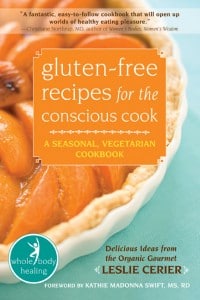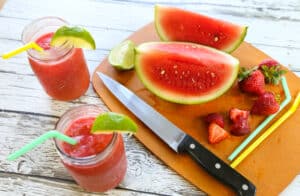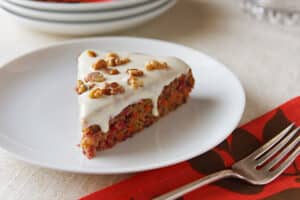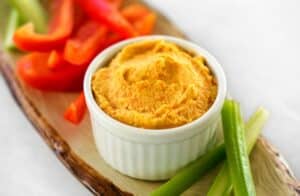 After months of migraines, my hands and feet going numb, stomach in knots and extreme dizziness and fatigue I found out I had gluten intolerance. And going gluten-free after 25 years of eating “normally” was and still is one of the hardest things I have ever done. I have been gluten-free for about four months now, and I am still finding it tough. Especially at get-togethers, I see the spread of food and can’t eat a single thing there. It is such a difficult thing to get used to and at first it seems like you might just starve to death. It gets even harder when you are strapped for time and cash AND being vegetarian or vegan. After months of research it hasn’t gotten much easier. If this sounds like what you’re going through, or if you just want to eat better, I would pick up Leslie Cerier’s Gluten-free Recipes for the Conscious Cook: A Seasonal Vegetarian Cookbook.* I am so thankful I was given this book and I use it as a guide everyday. All the information is laid out in a way that is easy to use and understand and the recipes and tips make the possibilities of gluten-free eating endless. Even if you don’t have gluten intolerance or Celiac’s, a gluten-free diet is much better for you…for everybody!
After months of migraines, my hands and feet going numb, stomach in knots and extreme dizziness and fatigue I found out I had gluten intolerance. And going gluten-free after 25 years of eating “normally” was and still is one of the hardest things I have ever done. I have been gluten-free for about four months now, and I am still finding it tough. Especially at get-togethers, I see the spread of food and can’t eat a single thing there. It is such a difficult thing to get used to and at first it seems like you might just starve to death. It gets even harder when you are strapped for time and cash AND being vegetarian or vegan. After months of research it hasn’t gotten much easier. If this sounds like what you’re going through, or if you just want to eat better, I would pick up Leslie Cerier’s Gluten-free Recipes for the Conscious Cook: A Seasonal Vegetarian Cookbook.* I am so thankful I was given this book and I use it as a guide everyday. All the information is laid out in a way that is easy to use and understand and the recipes and tips make the possibilities of gluten-free eating endless. Even if you don’t have gluten intolerance or Celiac’s, a gluten-free diet is much better for you…for everybody!
Gluten is a protein present in wheat, barley and rye. It’s difficult to digest and doesn’t benefit us much. Manufacturers pump foods with it to give them longer shelf life and to taste better. The forward by Kathie Madonna Swift is a great briefing on the affects of gluten and the positive changes that come from going gluten-free. She says how changing to a GF diet can “prevent and cure many chronic health conditions” (IBS, migraines, chronic fatigue, neurological problems, diabetes, thyroid, obesity) and it can improve “autoimmune, inflammatory, gastrointestinal, dermatological and some neurological conditions.” It not only affects us, but it impacts the Earth. Wheat and other gluten grains are grown with harmful chemicals, while gluten-free grains can be grown without these methods. As Cerier says, “more nutrition from the same amount of land” because GF grains “offer superior nutrition and higher quality protein.”
Leslie Cerier treats GF cooking as an art form and a sport because you can transform the colors, shapes and textures of these grains and foods as you like, making them taste and look great! The first chapter is dedicated to introducing the GF grains: amaranth, buckwheat, corn millet, oats, quinoa, rice, sorghum, teff and wild rice. Cerier provides descriptions of each, as well as other useful ingredients like coconut flour and nut and seed meals. The second chapter gives instructions and suggestions on cooking GF grains and includes charts on liquid to grain ratios, which is one of my favorite things about this book (along with the glossary of ingredients and resources in the back of the book!). After this all the chapters are loaded with amazing recipes: breakfasts, main courses, sushi, sides, sauces and toppings and desserts. I won’t stop till I make and try them all. It is my dream guide to gluten-free cooking and as soon as you pick it up I guarantee it will be yours too!
You can find some of Leslie's recipes from Gluten-free Recipes for the Conscious Cook: A Seasonal Vegetarian Cookbook* right here on VegKitchen:
Leslie Cerier (a.k.a “The Organic Gourmet”) is also the author of The Quick and Easy Organic Gourmet* and Going Wild in the Kitchen.* To learn more about Leslie, her classes, organic catering and consultations visit her website. Make sure to check out the many recipes on VegKitchen provided by Leslie.
- Read more of VegKitchen’s book reviews.
*This post contains affiliate links. If the product is purchased by linking through this review, VegKitchen receives a modest commission, which helps maintain our site and helps it to continue growing!





Comments
No Comments